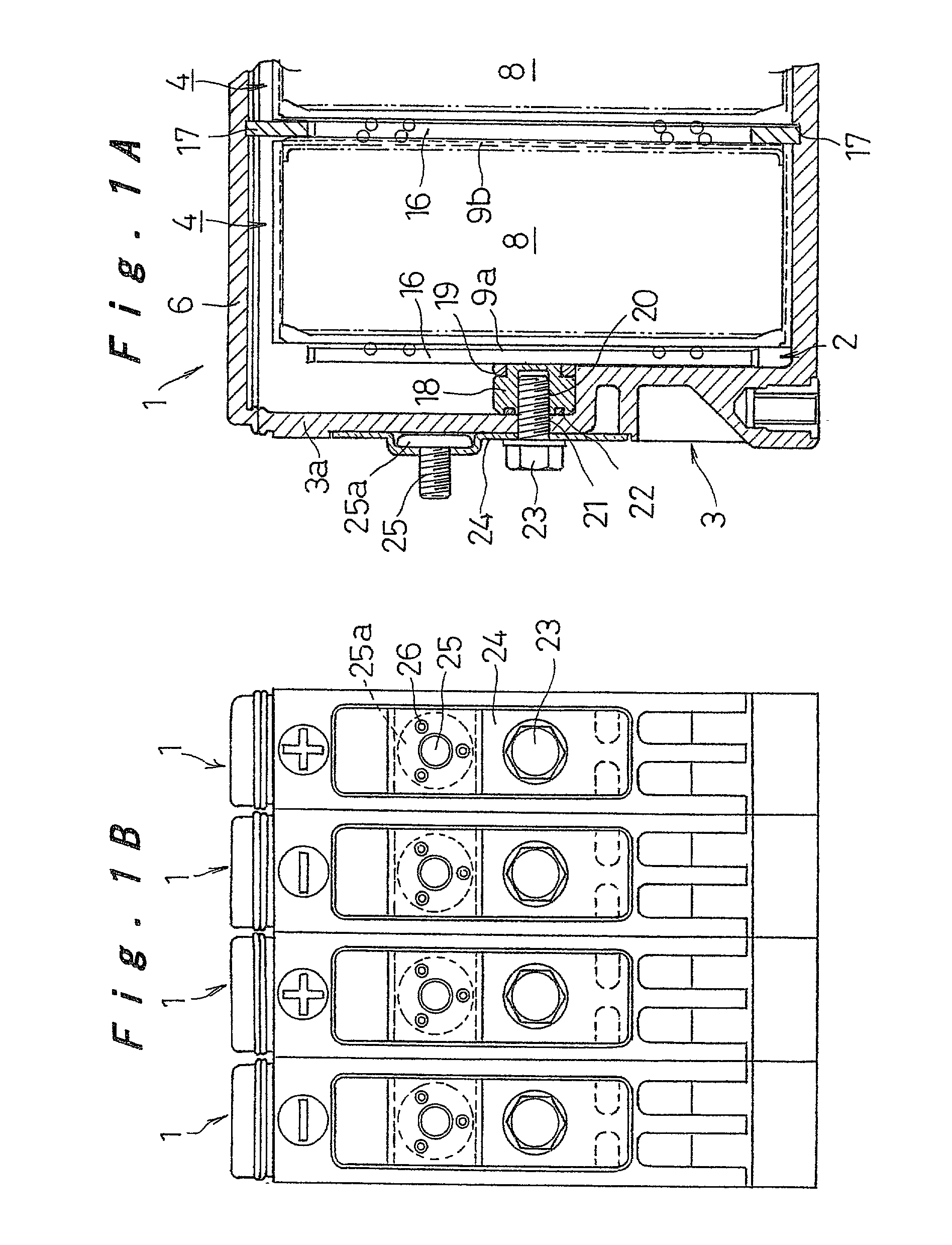Prismatic sealed battery module
a battery module and sealed technology, applied in the direction of cell components, flat cell grouping, sustainable manufacturing/processing, etc., can solve the problems of large number of constitution parts, undesirable increase in cost, and difficulty in improving power output and service life characteristics of rechargeable battery modules, so as to reduce losses
- Summary
- Abstract
- Description
- Claims
- Application Information
AI Technical Summary
Benefits of technology
Problems solved by technology
Method used
Image
Examples
first embodiment
[0022]Hereinafter, a first embodiment of a prismatic sealed battery module according to the present invention will be described with reference to FIGS. 1A and 1B.
[0023]In FIGS. 1A and 1B, a prismatic sealed battery module 1 of the first embodiment incorporates a plurality of cells 2 made of nickel-metal hydride rechargeable batteries. The reference numeral 3 denotes a prismatic battery case, which is formed in the shape of a flat prism by juxtaposing prismatic cell cases 4 with a shorter side surface and a longer side surface, each of whose shorter side surfaces is common to adjacent such cell cases. An upper opening of the prismatic battery case 3 is sealed with an integrally-formed cover 6. The cell 2 is constituted by housing in the cell case 4 an electrolyte and an electrode plate group 8 formed by layering rectangular positive and negative electrode plates with a separator interposed therebetween. Part of the positive and negative electrode plates of the electrode plate group 8...
second embodiment
[0033]Next, a second embodiment of the prismatic sealed battery module according to the invention will be described with reference to FIGS. 2A and 2B. Note that, in the descriptions connected to the second embodiment, such elements as are found also in the previous embodiment are identified with the same reference numerals and symbols, and the descriptions thereof will be omitted. That is, only the points of difference will be described below.
[0034]In this embodiment, instead of the externally connecting bolt 23 of the first embodiment, an externally connecting bolt 27 is used that is provided integrally with a concentrically-formed external terminal 25.
[0035]According to the second embodiment, there is no need to additionally provide the connection plate 24, to which the external terminal 25 is fixed, as used in the first embodiment. Thus, the number of constitution parts is reduced, thereby making cost reduction possible.
third embodiment
[0036]Next, a third embodiment of the prismatic sealed battery module according to the invention will be described with reference to FIGS. 3A through 4B.
[0037]In this embodiment, instead of the connection plate 24 of the first embodiment with the external terminal 25 attached to it, there is provided an externally connection plate 28 having a substantially L-shaped cross-sectional profile. As shown in FIGS. 3A through 4B, the external connection plate 28 includes a fitting portion 29 and a connecting portion 30 adjoining thereto. The fitting portion 29 makes contact with the outer surface of the side end wall 3a of the prismatic battery case 3, and the connecting portion 30 makes contact with the end of the longer side of the prismatic battery case 3. The fitting portion 29 is fastened to the metal connector 18 with the externally connecting bolt 23. In a bend between the fitting portion 29 and the connecting portion 30 is provided a U-shaped elastic portion 31. As shown in FIG. 4B,...
PUM
| Property | Measurement | Unit |
|---|---|---|
| current | aaaaa | aaaaa |
| length | aaaaa | aaaaa |
| elastic | aaaaa | aaaaa |
Abstract
Description
Claims
Application Information
 Login to View More
Login to View More - R&D
- Intellectual Property
- Life Sciences
- Materials
- Tech Scout
- Unparalleled Data Quality
- Higher Quality Content
- 60% Fewer Hallucinations
Browse by: Latest US Patents, China's latest patents, Technical Efficacy Thesaurus, Application Domain, Technology Topic, Popular Technical Reports.
© 2025 PatSnap. All rights reserved.Legal|Privacy policy|Modern Slavery Act Transparency Statement|Sitemap|About US| Contact US: help@patsnap.com



